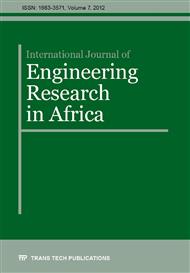[1]
A. B. Koehler, Forecasting models and prediction intervals for the multiplicative Holt-Winters method, International Journal of Forecasting 17 (2001) 269-286.
DOI: 10.1016/s0169-2070(01)00081-4
Google Scholar
[2]
R.I. Phelps, Optimal inventory rule for a linear trend in demand with a constant replenishment period, Journal of the Operational Research Society 31 (1980) 439-442.
DOI: 10.1057/jors.1980.78
Google Scholar
[3]
M.W. Watson, R.G. King, C. I. Plosser and J. H. Stock, Stochastic Trends and Economic Fluctuations, American Economic Review 81 (1991) 819-840.
DOI: 10.3386/w2229
Google Scholar
[4]
A. Mitra, J.F. Cox, and R.R. Jesse, A note on determining order quantities with a linear trend in demand, Journal of the Operational Research Society 35 (1984) 141-144.
DOI: 10.1057/jors.1984.21
Google Scholar
[5]
H. Arsham, Time-Critical Decision Making for Business Administration, Information on http: /home. ubalt. edu/ntsbarsh/stat-data/Forecast. htm. Retrieved December (2009).
Google Scholar
[6]
G. C Reinsel, G. E Box and G. M Jenkins, Time Series Analysis. Pearson Education (2003).
Google Scholar
[7]
Reddy Timma, Forecasting using Decomposition and Combination of Experts. Technical Report, Kanwal Rekhi School of Information Technology, IIT Bombay (2005).
Google Scholar
[8]
Seth Abhishek, On Using a Multitude of Time Series Forecasting Models, Master's Thesis, Kanwal Rekhi School of Information Technology, IIT Bombay (2005).
Google Scholar
[9]
Singh Rajveer, On Using Various Decomposition Methods in Time Series Forecasting, Master's Thesis, Kanwal Rekhi School of Information Technology, IIT Bombay (2005).
Google Scholar
[10]
Yang Yuhong and Hui Zou, Combining time series model for forecasting, International Journal of Forecasting (2004).
Google Scholar
[11]
W.M. Persons, Correlation of time series, Journal of American Statistical Association, 18 (1923) 5–107.
Google Scholar
[12]
C.C. Holt, Forecasting seasonal and trends by exponentially weighted moving averages, Office of Naval Research, Memorandum No. 52 (1957).
Google Scholar
[13]
P. R Winters, Forecasting Sales by Exponentially Weighted Moving Averages, Management Science 6 (1960) 324-342.
DOI: 10.1287/mnsc.6.3.324
Google Scholar
[14]
G.E.P. Box and G.M. Jenkins, Time Series Analysis: Forecasting and Control, Revised ed. San Fransisco: Holden-Day (1976).
Google Scholar
[15]
G. Zhang, B.E. Patuwo and M.Y. Hu, Forecasting with artificial neural networks: The state of the art, International Journal of Forecasting, 14 (1998) 35–62.
DOI: 10.1016/s0169-2070(97)00044-7
Google Scholar
[16]
M. Nelson, T. Hill, T. Remus and M. O'Connor, Time series forecasting using NNs: Should the data be deseasonalized first?, Journal of Forecasting, 18 (1999) 359–367.
DOI: 10.1002/(sici)1099-131x(199909)18:5<359::aid-for746>3.0.co;2-p
Google Scholar
[17]
J.V. Hansen and R.D. Nelson, Forecasting and recombining time-series components by using neural networks, Journal of the Operational Research Society, 54 (3) (2003) 307–317.
DOI: 10.1057/palgrave.jors.2601523
Google Scholar
[18]
P. Esmikol, Modeling Demand. Information on https: /www. student. gsu. edu/%7Esmikol. Retrieved December (2009).
Google Scholar
[19]
P. H Smith, Optimal production policies for items with decreasing demand, European Journal of Operational Research 1 (1977) 365-367.
DOI: 10.1016/0377-2217(77)90045-5
Google Scholar
[20]
B.L. Bowerman, and O'Connel, Forecasting and Time Series: An Applied Approach, 3rd ed, Belmont, California, Duxbury Press, (1993).
Google Scholar
[21]
George Box, Gwilym M. Jenkins and Gregory C. Reinsel. Time Series Analysis: Forecasting and Control, third edition. Prentice-Hall, (1994).
DOI: 10.1111/jtsa.12194
Google Scholar
[22]
G.E.P. Box, D.A. Pierce and P. Newbold, Estimating Trend and Growth Rates in Seasonal Time Series, Journal of the American Statistical Association 82 (1987) 276-282.
DOI: 10.1080/01621459.1987.10478430
Google Scholar
[23]
V. Assimakopoulos, and K. Nikolopoulos, The Theta Model: a Decomposition Approach to Forecasting, International Journal of Forecasting 16 (2000) 521-530.
DOI: 10.1016/s0169-2070(00)00066-2
Google Scholar
[24]
F. Busetti, and A.C. Harvey, Seasonality tests, Journal of Business and Economic Statistics 21, (2003) 420-436.
DOI: 10.1198/073500103288619061
Google Scholar
[25]
A. G. Bruce and S. R. Jurke, Non-Gaussian Seasonal Adjustment: X-12-ARIMA versus Robust Structural Models, Journal of Forecasting 15 (1996) 305-28.
DOI: 10.1002/(sici)1099-131x(199607)15:4<305::aid-for626>3.0.co;2-r
Google Scholar


